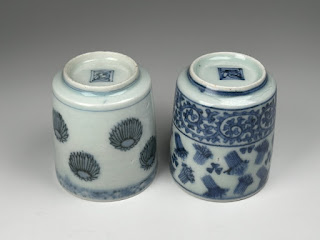菊花文 のぞき猪口 Chrysanthemum Nozoki-type Cup
上に向かってじゃっかん末広がりな形をしたのぞき猪口。上下互い違いに8個描かれる文様は菊の花とされる(たとえば中島由美 編「古伊万里 蕎麦猪口・酒器 1000」17ページ、講談社、2001年;「小さな蕾」2020年10月号、24ページ、創樹社美術出版、など)。古伊万里界隈では皇室の紋章のような抽象化された菊文のほうが出現頻度が高いとおもうが、これは重力によって花びらが垂れ下がった具象的な菊文で、レア度はやや高いだろう。一般に古伊万里は器全面を文様で埋め尽くす傾向にあるが、これは白磁の余白をのこしたデザインだ。ちょっとしたユーモアが感じられる。
A nozoki-type small Imari cup with a top rim slightly wider than the bottom. Eight marks drawn in an alternate way mean chrysanthemum flower. I think this type of chrysanthemum hanging down under gravity is rarer in old Imari wares than more abstract symbol like the Imperial seal of Japan. The design leaving white margin is also comparatively rarer in old Imari wares. I think it has a bit sense of humor.
これとほとんど同じ形状をした猪口(以前こちらで紹介した)と並べてみたのが上の写真である。どちらも文様の描き方や配置がシャレている。渦福銘や縁べりの四方襷文の描き方もおなじで、同一工房でほぼ同じ時期につくられたのではないかと推測する。
The above photo compares two nozoki-type cups, one of which has been shown in this blog. There are similarities in the shape, the bottom mark, the way of arranging the pattern, and the pattern inside/outside the top rim. I guess they were created in the same pottery at a similar time.


